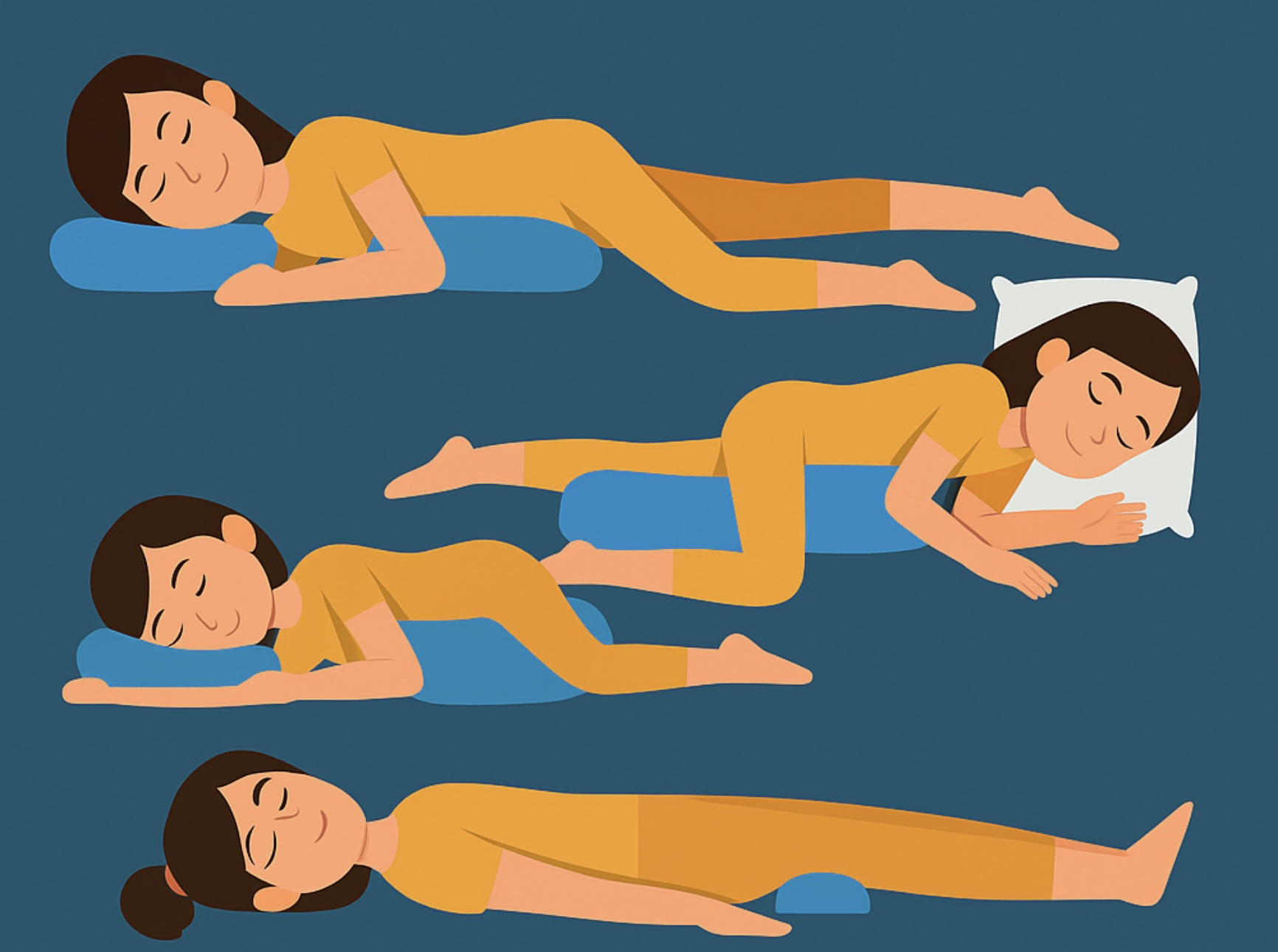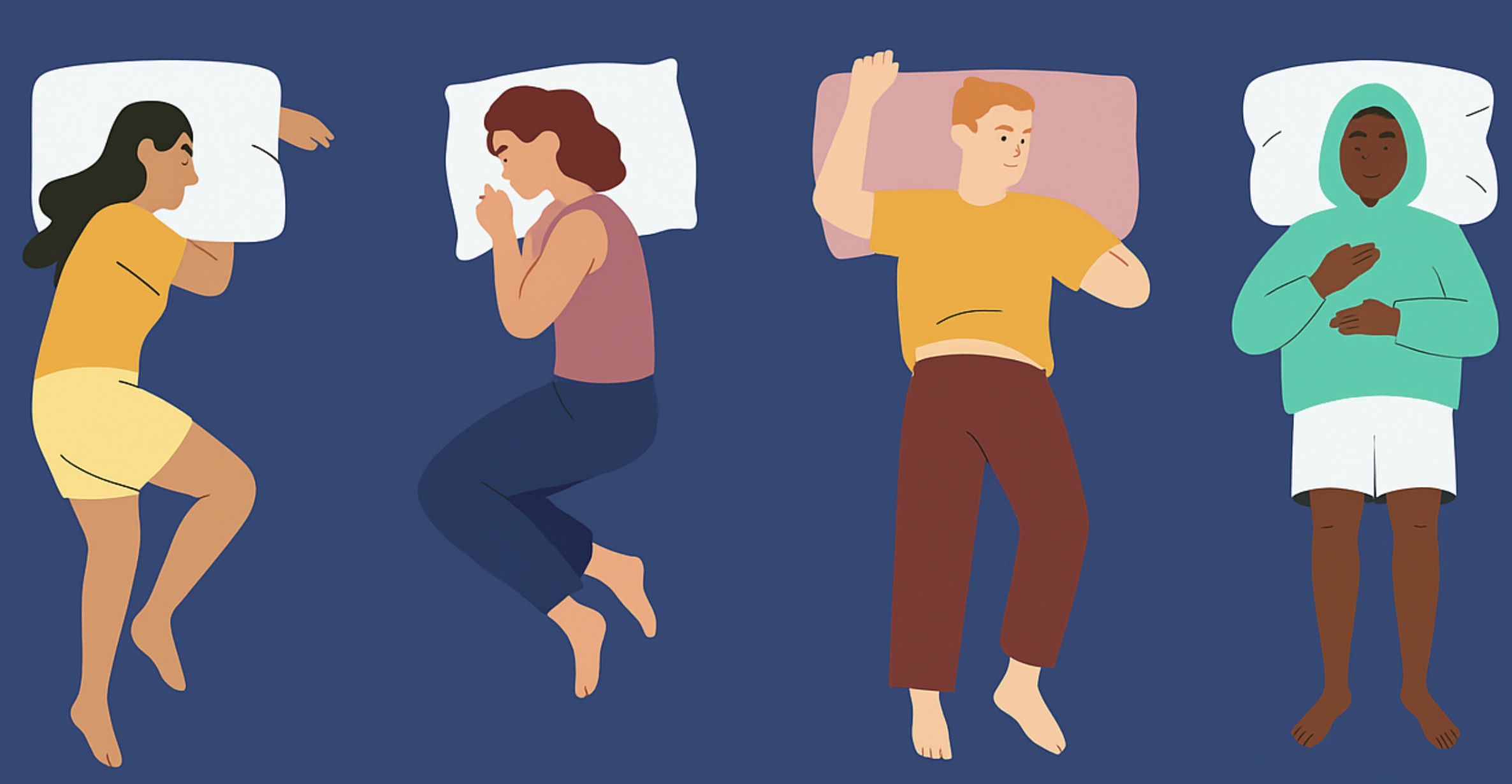.jpg)
You have probably heard that different people have different sleeping positions. Some people like sleeping on their sides, some people like sleeping on their backs, and others like sleeping on their stomachs.
Your sleeping position may seem like a matter of personal preference, but emerging research has actually revealed that how you position your body during those crucial 7-9 hours of rest can significantly impact your health. From brain waste clearance to cardiovascular function, your nightly posture plays a more important role than you might think. Understanding which side is best for sleeping is one of the first steps toward improving your nightly rest.

Sleep positioning affects multiple physiological systems simultaneously. During sleep, your body undergoes critical restorative processes, from memory consolidation to cellular repair. The position you maintain throughout the night can either support or hinder these vital functions. If you're looking to improve your sleep quality, understanding optimal positioning is crucial.
Recent advances in sleep medicine have revealed that sleep position influences everything from spinal alignment to the brain's ability to clear metabolic waste. For those struggling with sleep issues, exploring natural sleep remedies alongside proper positioning can provide comprehensive improvement. Your sleep style directly impacts how well your body can perform these essential recovery functions.
Side sleeping, particularly on the left side, has emerged as the most physiologically beneficial position for most people. Research using dynamic-contrast-enhanced MRI shows that glymphatic transport is most efficient in the lateral position compared with supine or prone positions. Research using flexible wearable sensors also shows that side sleepers or subjects who prefer side sleeping experience better sleep quality than those who sleep on their back, with higher frequency of position changes during sleep reducing overall sleep quality.
There have been several demonstrated medical benefits of left-side sleeping including:
Right-side sleeping remains safe and beneficial, though slightly less optimal than left-side sleeping for certain conditions. A 2018 study found that patients with cardiomyopathy prefer sleeping on their right side rather than their left, suggesting the body may naturally gravitate toward positions that provide comfort for specific health conditions.
Many side sleepers naturally adopt the fetal position, which can provide additional comfort and support. This sleep style involves sleeping on your side with knees drawn up toward your chest, offering spinal support while maintaining the benefits of lateral positioning.

Back sleeping offers certain advantages for these back sleepers, particularly for spinal alignment. This position can help maintain the natural curvature of the spine and reduce pressure points. However, back sleeping also presents significant risks for certain populations particularly those with sleep apnea and those who are pregnant.
Most people with sleep apnea have much worse sleep apnea when they sleep on their back versus on their sides. The supine position can cause the tongue and soft tissues to collapse backward, obstructing the airway and worsening breathing difficulties during sleep. This can also contribute to sinus pain and teeth grinding as the body struggles to maintain proper breathing patterns. If you suspect you may have signs of sleep apnea, it's important to consult with a healthcare provider and avoid back sleeping.
For pregnant women, the risks of back sleeping increase significantly, especially after 28 weeks of pregnancy. Research has shown that back sleeping increases stillbirth risk in the third trimester, with the advice being to sleep on your side because it is safer for your baby.
Prone sleeping (stomach sleeping) or stomach sleepers typically presents the most challenges for healthy sleep positioning. Studies show that prone position impairs brain clearance, characterized by "retention" of the tracer, slower clearance, and more CSF efflux along larger caliber cervical vessels.
This position can strain the neck and spine due to the necessary head rotation and may compress breathing pathways. This can lead to wear and tear of the neck area over time, often resulting in neck pain and stiff neck symptoms upon waking. Many stomach sleepers report experiencing chronic neck pain from the prolonged rotation required in this sleeping position.
There are certain health conditions where different sleep styles would be more beneficial. Let's go through each one of them!
Sleep position and sleep posture play a crucial role in managing acid reflux symptoms. Clinical trials using electronic sleep positional therapy devices show that left lateral position alleviates reflux symptoms compared with other positions. For those experiencing nighttime heartburn, combining proper sleep positioning with other natural sleep strategies can provide significant relief.
The mechanism involves gravity and anatomy: The left lateral decubitus position is associated with reduced acid exposure time compared to right, supine, and prone positions.
For individuals with heart conditions, sleep position can significantly impact comfort and safety. Patients with heart failure avoid the left lateral decubitus position spontaneously during sleep, possibly as a protective strategy to avoid discomfort from the enlarged heart beat or further hemodynamic compromise.
We asked Dr. Shiyan Yeo, Internal Medicine Physician and Sleep Medicine Expert, what her clinical experience reveals about sleep positioning for patients with cardiovascular conditions. She says:
"While side sleeping is generally beneficial for most people, patients with specific heart conditions may naturally gravitate toward positions that provide them the most comfort and optimal blood flow, which is why individualized medical guidance is essential for those with cardiovascular disease."
In other words, people with heart conditions should work closely with their healthcare providers to determine the safest and most comfortable sleep position for their specific medical situation.
Sleep position and sleep posture directly affect spinal alignment and can influence morning stiffness and pain levels. Controlled studies show fewer back pain complaints in groups receiving sleeping position intervention compared to control groups who don't receive positional guidance. If you're waking up tired or experiencing morning pain, your sleep position may be a contributing factor.
Many people who suffer from lower back pain find that their sleep style significantly impacts their symptoms. Back sleepers may experience relief from lower back pain when proper spinal support is maintained, while those with existing back pain often find side sleeping more comfortable.
A scoping review examining relationships between sleep posture and spinal symptoms found preliminary evidence suggesting connections between sleep position and waking spinal symptoms, though more high-quality studies are needed.
The discovery of the glymphatic system has revolutionized our understanding of sleep's role in brain health. The glymphatic system functions as a macroscopic waste clearance system, with the vast majority of waste clearance occurring during sleep, and lifestyle choices including sleep position modulating this clearance.
This brain "washing" system is crucial for preventing neurodegenerative diseases. Sleep helps glymphatic system remove brain waste solutes, with astrocytes expanding and contracting to form channels for cerebrospinal fluid to wash through the brain and eliminate waste. For those looking to enhance restorative sleep naturally, understanding this connection between position and brain health is essential.
We asked Dr. Michael Grandner, Sleep Expert and Professor of Neuroscience and Physiological Sciences, what his research can tell us about sleep position and brain health. He says:
"Side sleeping, particularly left-side sleeping, optimizes the brain's natural waste clearance system during sleep, which is critical for long-term cognitive health and may help reduce the risk of neurodegenerative diseases."
In other words, the position we choose for sleep directly impacts our brain's ability to perform essential maintenance and repair functions.
Sleep position during pregnancy requires special consideration, particularly in the third trimester. Research shows that side sleeping halves stillbirth risk compared with going to sleep on your back from 28 weeks of pregnancy.
However, studies evaluating sleep position up to 30 weeks of pregnancy found that early pregnancy position doesn't affect complication risk, providing reassurance for women in their first and second trimesters.

If you're used to sleeping in a less optimal position, gradual changes work best. Learning how to improve your sleep habits through proper positioning is part of comprehensive sleep hygiene:
We asked Dr. Suzanne Gorovoy, Sleep Expert, Clinical Psychologist, and Behavioral Sleep Medicine Specialist, what her experience can tell us about successfully changing sleep positions and sleep styles. She says:
"The key to transitioning to a healthier sleep position is making gradual adjustments and using environmental cues like pillows and body positioning aids rather than forcing an abrupt change that could disrupt sleep quality."
In other words, successful sleep position changes require patience and the right supportive tools to make the transition feel natural and comfortable.
GERD sufferers: Sleep on your left side with the head of the bed elevated 6-8 inches
Pregnant women (after 28 weeks): Sleep on either side, with left side slightly preferred
Sleep apnea patients: Avoid back sleeping; side sleeping is strongly recommended to reduce sinus pain and minimize teeth grinding
Heart conditions: Consult your physician, as individual recommendations may vary based on your specific condition
Anxiety-related sleep issues: If you experience sleep anxiety or jolts of anxiety when falling asleep, proper positioning combined with relaxation techniques can help
One of the most groundbreaking discoveries in sleep medicine over the past decade has been the identification of the glymphatic system, essentially the brain's "garbage disposal" that operates primarily during sleep.
A landmark 2015 study published in The Journal of Neuroscience used advanced MRI imaging to demonstrate that sleep position affects brain clearance efficiency. Researchers found that lateral sleeping positions were superior to supine or prone positions for brain waste clearance.
This discovery has profound implications for understanding neurodegenerative diseases. The research suggests that lifestyle choices could alter Alzheimer's disease risk through improved glymphatic clearance and could be used as a preventative intervention for both healthy brain aging and Alzheimer's disease.
The implications extend beyond individual health choices. Recent research published in Nature Communications reveals that glymphatic function exhibits circadian rhythms, with clearance peaking during the mid-rest phase, while cerebrospinal fluid drainage to lymph nodes shows daily variation opposite to glymphatic influx.
This circadian relationship emphasizes that not only what position we sleep in matters, but when we sleep relative to our natural biological rhythms.

Sleep position does matter for your health, but it's not one-size-fits-all. The evidence strongly supports side sleeping, particularly left-side sleeping, for most healthy adults. However, individual health conditions, pregnancy status, and personal comfort levels should all factor into your optimal sleep positioning strategy.
The key is finding a position that allows for restorative sleep while supporting your body's physiological needs. Research demonstrates that sleep quality improves when people sleep in positions that align with their body's natural preferences while avoiding positions that compromise breathing or circulation. If you're struggling with persistent sleep issues, consider exploring comprehensive sleep improvement strategies or even sleep coaching for personalized guidance.
Remember, the "best" sleeping position is ultimately one that allows you to achieve deep, restorative sleep consistently. For those dealing with chronic sleep difficulties, sleep maintenance insomnia or other persistent issues, combining optimal sleep positioning with evidence-based treatments like CBT for insomnia can provide the most comprehensive improvement. If you have specific health concerns or chronic conditions, consult with your healthcare provider to determine the optimal sleep positioning strategy for your individual needs.
Quality sleep in the right position isn't just about comfort, it's an investment in your long-term health and cognitive function. For comprehensive sleep improvement, consider exploring sleep hygiene best practices alongside optimal positioning for the most impactful results.

Dr. Shiyan Yeo
Dr. Shiyan Yeo is a medical doctor with over a decade of experience treating patients with chronic conditions. She graduated from the University of Manchester with a Bachelor of Medicine and Surgery (MBChB UK) and spent several years working at the National Health Service (NHS) in the United Kingdom, several Singapore government hospitals, and private functional medicine hospitals. Dr. Yeo specializes in root cause analysis, addressing hormonal, gut health, and lifestyle factors to treat chronic conditions. Drawing from her own experiences, she is dedicated to empowering others to optimize their health. She loves traveling, exploring nature, and spending quality time with family and friends.